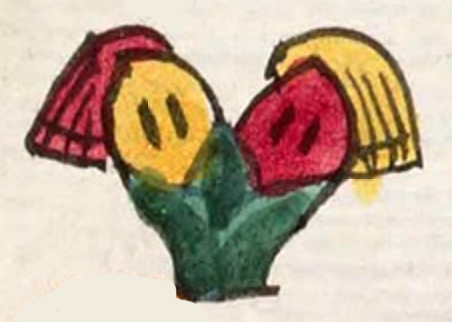xilotl (Mdz26r)
This element for tender, fresh ears of maize/corn (xilotl) has been carved from the compound glyph for the place name Xilotzinco. This version of xilotl offers two tender ears of maize, one red with a yellow tassel (corn silk), and one yellow with a red tassel (corn silk). Both ears are nestled into three green leaves. Each ear has two parallel vertical black hash marks.
Stephanie Wood
The two black marks on each of the ears of maize give the impression of eyes, seemingly anthropomorphizing the maize, which was a phenomenon across the hemisphere prior to contact, from the hero twins story of the Maya zone and on pottery in northern Peru, as two examples. The murals at Cacaxtla have very distinct human (or anthropomorphized deity) faces on the cobs of corn that are growing on stalks. The term xilotl has also been associated with the corn silk (cabellitos in Spanish), itself, which would then provide a rationale for having a face on the ears of corn if the silk is to be considered as hair. See: Cecilio Agustín Robelo, Diccionario de Aztequismos (1904), 427.)
For another representation of maize that has a very similar look to these cobs, see Marc Thouvenot's vignette about Chicomecohuatl from the Códice Matritense del Palacio Real, https://vignettes.sup-infor.com/imagen/4-PR_01_262r_a.
Stephanie Wood
c. 1541, or by 1553 at the latest
Stephanie Wood
Crystal Boulton-Scott made the SVG.
cobs, ears, maize, corn, maíz, elote, milpa

xilo(tl), tender maize ear, https://nahuatl.wired-humanities.org/content/xilotl
fresh, green, tender corn cobs or ears
la mazorca tierna, el jilote, el elote
Stephanie Wood
Codex Mendoza, folio 26 recto, https://digital.bodleian.ox.ac.uk/objects/2fea788e-2aa2-4f08-b6d9-648c00..., image 64 of 188.
The Bodleian Libraries, University of Oxford, hold the original manuscript, the MS. Arch. Selden. A. 1. This image is published here under the UK Creative Commons, “Attribution-NonCommercial-ShareAlike 3.0 License” (CC-BY-NC-SA 3.0).




